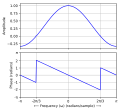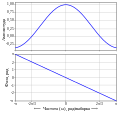File:Amplitude & phase vs frequency for 3-term boxcar filter.svg

Size of this PNG preview of this SVG file: 435 × 400 pixels. Other resolutions: 261 × 240 pixels | 522 × 480 pixels | 835 × 768 pixels | 1,114 × 1,024 pixels | 2,227 × 2,048 pixels.
Original file (SVG file, nominally 435 × 400 pixels, file size: 20 KB)
File history
Click on a date/time to view the file as it appeared at that time.
| Date/Time | Thumbnail | Dimensions | User | Comment | |
|---|---|---|---|---|---|
| current | 13:04, 1 October 2020 |  | 435 × 400 (20 KB) | Krishnavedala | Text-to-graph aspect ratio renders poorly in thumbnails with text unreadable. |
| 01:25, 3 July 2019 |  | 512 × 512 (42 KB) | Bob K | change graph "linewidth" to 2 | |
| 13:03, 2 July 2019 |  | 512 × 512 (42 KB) | Bob K | Enlarge image. Add title. Improve rendering of "pi" symbols. | |
| 16:23, 22 August 2017 |  | 435 × 400 (20 KB) | Krishnavedala | corrections on phase plot | |
| 16:11, 22 August 2017 |  | 435 × 400 (20 KB) | Krishnavedala | new version using Matplotlib | |
| 15:26, 21 August 2017 |  | 512 × 384 (42 KB) | Krishnavedala | thicker lines and uses unicode text | |
| 22:01, 16 August 2017 |  | 576 × 432 (43 KB) | Krishnavedala | Use Unicode for Greek symbols | |
| 21:58, 16 August 2017 |  | 576 × 432 (43 KB) | Krishnavedala | Unicode symbols corrected | |
| 21:52, 16 August 2017 |  | 576 × 432 (43 KB) | Krishnavedala | regenerate using "gnuplot" backend | |
| 21:31, 16 August 2017 |  | 576 × 431 (28 KB) | Krishnavedala | User created page with UploadWizard |
File usage
The following pages on the English Wikipedia use this file (pages on other projects are not listed):
Global file usage
The following other wikis use this file:
- Usage on zh.wikipedia.org


